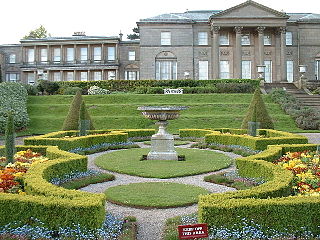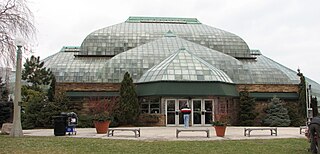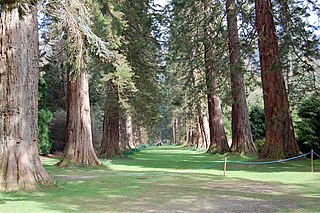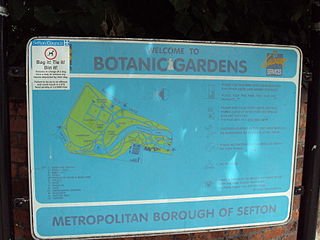
Logan Botanic Garden is a botanical garden near Port Logan on the Rhins of Galloway, at the south-western tip of Scotland. It is operated as part of the Royal Botanic Garden Edinburgh's Living Collection. It has been described as "Scotland's most exotic garden."

The Birmingham Botanical Gardens are a 15-acre (6-hectare) botanical garden situated in Edgbaston, Birmingham, England. The gardens are located 1+1⁄2 miles (2.4 km) south-west of Birmingham city centre at grid reference SP049854. Designed in 1829, the gardens are Grade II* listed in Historic Englands's Register of Parks and Gardens, and retain many original features and layout, which was designed by the landscape gardener and horticulturalist John Claudius Loudon. The site is notable for its range of glasshouses and gardens, which display a wide variety of plants and previously, birds. Birmingham Botanical Gardens is managed by Birmingham Botanical and Horticultural Society, a registered charity. The gardens are open daily to the public with paid admission.

The Royal Botanic Garden Edinburgh (RBGE) is a scientific centre for the study of plants, their diversity and conservation, as well as a popular tourist attraction. Founded in 1670 as a physic garden to grow medicinal plants, today it occupies four sites across Scotland—Edinburgh, Dawyck, Logan and Benmore—each with its own specialist collection. The RBGE's living collection consists of more than 13,302 plant species, whilst the herbarium contains in excess of 3 million preserved specimens.

The University of Oxford Botanic Garden is the oldest botanic garden in Great Britain and one of the oldest scientific gardens in the world. The garden was founded in 1621 as a physic garden growing plants for medicinal research. Today it contains over 5,000 different plant species on 1.8 ha. It is one of the most diverse yet compact collections of plants in the world and includes representatives from over 90% of the higher plant families.

The Christchurch Botanic Gardens, located in the central city of Christchurch, New Zealand, were founded in 1863 when an English oak was planted to commemorate the solemnisation of the marriage of Prince Albert and Princess Alexandra of Denmark. The gardens sprawl over an area of 21 hectares and lie adjacent to the loop of the Avon River next to Hagley Park. The Christchurch Botanic Gardens have a variety of collections of exotic and local plants of New Zealand, several conservatories, a nursery, playground and Climatological Station.

Phipps Conservatory and Botanical Gardens is a botanical garden set in Schenley Park, Pittsburgh, Pennsylvania, United States. It is a City of Pittsburgh historic landmark and is listed on the National Register of Historic Places.

Tatton Park is a historic estate in Cheshire, England, north of the town of Knutsford. It contains a mansion, Tatton Hall; a medieval manor house, Tatton Old Hall; Tatton Park Gardens, a farm and a deer park of 2,000 acres (8.1 km2). It is a popular visitor attraction and hosts over a hundred events annually. The estate is owned by the National Trust and is managed under lease by Cheshire East Council. Since 1999, it has hosted North West England's annual Royal Horticultural Society flower show.

The Lincoln Park Conservatory is a conservatory and botanical garden in Lincoln Park in Chicago, Illinois. The conservatory is located at 2391 North Stockton Drive just south of Fullerton Avenue, west of Lake Shore Drive, and part of the Lincoln Park, Chicago community area. The Alfred Caldwell Lily Pool and the North Pond Nature Sanctuary are further to the north along Stockton Drive. Along with the Garfield Park Conservatory on Chicago's west side, the Lincoln Park Conservatory provides significant horticultural collections, educational programs and community outreach efforts.

Benmore Botanic Garden is a large botanical garden situated in Strath Eachaig at the foot of Beinn Mhòr, on the Cowal Peninsula, in Argyll and Bute, west of Scotland. The gardens are on the west side of the A815 road from Dunoon, between the Holy Loch and Loch Eck, and include footbridges across the River Eachaig. It is one of the sites of Royal Botanic Garden Edinburgh.
Coulport is a village on the east side of Loch Long and the west side of the Rosneath Peninsula, in Argyll and Bute, west of Scotland.

The Volunteer Park Conservatory is a botanical garden, conservatory, and Seattle landmark located in Seattle, Washington at the north end of Volunteer Park on Capitol Hill.

Pteridomania or fern fever was a Victorian craze for ferns. Decorative arts of the period presented the fern motif in pottery, glass, metal, textiles, wood, printed paper, and sculpture, with ferns "appearing on everything from christening presents to gravestones and memorials".

Tatton Park Gardens consist of formal and informal gardens in Tatton Park to the south of Tatton Hall, Cheshire, England. Included in the gardens are an Italian garden, a walled garden, a rose garden, and the Japanese garden. The buildings in the garden are the Conservatory, the Fernery and the Showhouse. The gardens are owned by the National Trust and administered by Cheshire East Council. They are on the National Register of Historic Parks and Gardens and have been designated at Grade II*. The gardens are open to the public at advertised times.

Kew Gardens is a botanic garden in southwest London that houses the "largest and most diverse botanical and mycological collections in the world". Founded in 1840, from the exotic garden at Kew Park, its living collections include some of the 27,000 taxa curated by Royal Botanic Gardens, Kew, while the herbarium, one of the largest in the world, has over 8.5 million preserved plant and fungal specimens. The library contains more than 750,000 volumes, and the illustrations collection contains more than 175,000 prints and drawings of plants. It is one of London's top tourist attractions and is a World Heritage Site.

Southport Botanic Gardens is a botanical garden situated in the suburban village of Churchtown, Southport, in Merseyside, England. It is often called "The Jewel in the Crown" as it is nationally known for its floral displays, which have been featured in the BBC TV program Gardener's World.

Cook Park is a heritage-listed 4-hectare (10-acre) urban park at 24–26 Summer Street, Orange, a city in the Central West region of New South Wales, Australia. It was designed and built by Alfred Patterson from 1873 to 1950. It is also known as Orange Botanic Garden. It was added to the New South Wales State Heritage Register on 24 August 2018. The park's main entrance is from the corner of Summer Street and Clinton Street.

The Anna Scripps Whitcomb Conservatory is a greenhouse and a botanical garden located on Belle Isle, a 982-acre (397-hectare) island park located on the Detroit River within Detroit, Michigan. While located near the Canada–United States border, the island is entirely within the U.S. The park itself consists of 13 acres of preserved land for the conservatory and its botanical garden.
James Duncan was a Scottish sugar refiner and businessman, who then became a philanthropist and art collector. His house and grounds on the Cowal peninsula in Argyll became Benmore Botanic Garden, now managed by the Royal Botanic Garden Edinburgh.

Puck's Glen is a river-formed ravine on the Cowal Peninsula, in Argyll and Bute, west of Scotland, with a popular scenic walking trail beside the Eas Mòr stream. In 2020 the glen and adjoining trails were closed temporarily due to COVID-19 restrictions, issues of stability of the gorge, and felling of trees infected by larch disease.
Professor Mary Gibby was a British botanist, pteridologist and cytologist. She was an expert on ferns, becoming president of the British Pteridological Society and long-time editor of its journal, the Fern Gazette. Gibby particularly studied the cytology of the genera Dryopteris and Pelargonium.


















